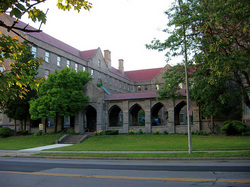Inequality in Inner City Schools
Phil DiLorenzo
The problem of inequality has been a defining characteristic in America since the beginning. When “Separate but equal” was deemed unconstitutional in the Brown v Board case in 1954, The Federal government has encountered difficulty when attempting to safely integrate white and minority schools under the same roof.
It’s no secret that the suburban schools around the Rochester area are more successful than inner city schools. Suburban schools receive more federal aid, as well as have better facilities, teachers, and programs. As a result, these high schools are among the top public schools in the nation.
Problems in Inner City Schools
But what about inner city public schools? They receive less federal aid, have poorer quality facilities and a sub- par curriculum, while carrying an embarrassingly low graduation rate (Circa 11% in some schools).
It is clear in some of these schools that education has taken a back seat to safety and discipline. Metal detectors and security guards grace the halls of the inner city schools, unlike in the suburban schools. “We would get shiny new metal detectors, but still have textbooks that fell apart” said Eric West, 20, a graduate from the School of the Arts. The money employing these safety precautions could be spent improving the schools; however safety took precedence in the minds of the Superintendent and those on the school board.
Inner city schools in Rochester start out at a disadvantage to suburban schools. Adding to the problem that they receive less federal aid is the majority of students come from underprivileged homes. Nearly 85% of boys and girls in inner city schools qualify for free or reduced lunches, further crippling the school system.
These kids come from unstable homes into school, often hungry and with inadequate healthcare. These are certainly not ideal circumstances for learning, nor are classrooms full of grumpy kids an environment for teaching.
Evalyn Gleason, 20, shared her experience as a white female who attended the School of the Arts, one of the many inner city schools in the area. Evalyn was from a middle class home and was in the minority as a white student in the high school of mostly Hispanic and African American decent. She easily could have attended a suburban school and received a better education, but her parents wanted to keep her in the urban school to expose her to diverse backgrounds and to expand her understanding of culture. “It gets difficult to learn when there are fights almost every day. It really distracts you,” said Evalyn.
The distractions are clear when you look at the statistics. 25% of students are at the proper reading level for their age or over, while only 5% of students are ready for college level reading by the time they graduate.
Suburban Schools
Suburban school districts on the other hand encounter no such predicaments. Most in the area are almost completely white. 3/5 of suburban schools schools in the greater Rochester area have less than 30 total black students. “Our concern is about our students feeling like they were in a very limited setting,” said Renee Williams, the assistant superintendent at Honeoy Falls- Lima school district. Some parents think that having their children in such a segregated environment puts their children at a disadvantage in the future, for college and for their jobs.
Building on previous statistics, only 4% of students at Pittsford high school qualify for free or reduced lunches at school and only 5% of students at Pittsford are of minority decent.
What is being done about this?
Clearly there is a problem with segregation in schools in the Rochester area, culturally and economically. One such solution to this is the Urban Suburban Interdistrict Transfer Program. Created in 1965, The Urban Suburban program was the first voluntary desegregation program in the United States. The program was designed to limit racial isolation between the white, middle class suburban schools and the poverty stricken inner city schools.
This program gives students from the Urban Schools a chance to experience a better learning environment in a Suburban school, and on occasion, vise versa. However, the program goes far deeper than this. By providing an easy application process, free transportation to their new school, and after school programs to help the kids acclimate to their new environment, this program has all the best intentions to make the switch as easy as possible for students. Over the years, the program has grown, adding a 5- week summer program, as well as adding more schools and students who are participating and an annual meeting and dinner for all involved. There are also SAT courses provided with the program, as well as college tours and scholarships for applicants. At this time, about ½ of the suburban schools in the area are participating, along with 500 total students. The hope for the program is for this number to grow even higher than it is, and to help provide a better cultural environment for all school districts involved.
The aforementioned statistics were provided in the article Segregated Schools Leave Children Behind by Tiffany Lankes, a staff writer for the Democrat and Chronicle.


